BMW C Evolution Electric Scooter
BMW announced the “C evolution” electric scooter in April of 2014.
The 2017 version is now ready to go and a slide show has been added below.
The C evolution is an electric scooter design based on the BMW e Scooter (report) previously announced by BMW.
The styling is also very reminiscent of the BMW C 650 GT (Review and Blog), first introduced at the 2010 EICMA show in Milan (report).
At that time, BMW announced a new Urban Mobility division, which will focus on scooters and other types of two-wheeled conveyances.
Pricing and availability of the C Evolution scooter wasn’t announced but should be available soon.
Following is a press release and photos issued by BMW, edited by webBikeWorld.com.
Dynamic Riding Fun With “Zero” Emissions
The arrival of the new C evolution marks the start of a new chapter in the urban mobility segment for BMW Motorrad.
The two conventionally powered maxi scooter models — the C 600 Sport and C 650 GT — already succeed in combining the superb ride qualities of a motorcycle with the specific agility of a scooter and the design’s inherent comfort.
The new electrically powered C evolution now goes even further by fusing riding fun and dynamism with the benefits of zero-emission performance to create a whole new experience on two wheels.
In keeping with the BMW Group’s sustainability strategy, BMW Motorrad is taking a fully committed approach to electric mobility.
As with BMW i, development of the C evolution revolved around creating a visionary vehicle concept offering maximum everyday practicality and an inspirational design.
(Editor’s Note: Of course, there is no such thing as “zero emissions”. The power comes from somewhere — hopefully not a “dirty” source…but is there a perfectly clean source?
Not even solar, but wouldn’t it be nice to plug your C evolution scooter into a solar grid instead of a coal-burning electric power plant?).
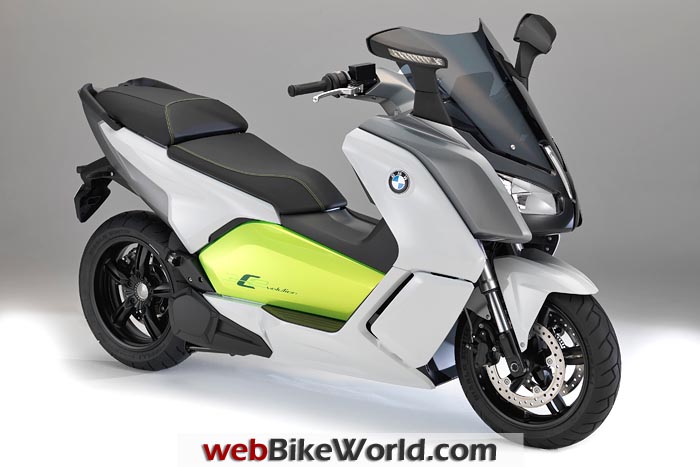
Performance
Dynamic performance of the C evolution is on a par with a conventionally powered maxi scooter.
With a rated output of 11 kW (15 hp, homologated according to regulation ECE R85 for measuring power) and a peak output of 35 kW (47 hp), the C evolution has plenty of power on tap.
Its maximum torque of 72 Nm is constantly available at motor speeds up to approx. 4,500 rpm.
The motor’s punchy performance means the C evolution can accelerate from 0 to 50 km/h (31 mph) in just 2.7 seconds, for example.
This is the sort of time achieved by today’s maxi scooters with displacements of 600 cc or more and translates into tremendous riding fun.
The top speed is electronically limited to 120 km/h (75 mph).
[UPDATED: In the new C evolution Long Range the continuous output is 19 kW (26 hp), 8 kW (11 hp) more than in the predecessor model, while the range has been significantly extended to approximately 160 kilometers.
The top speed is 129 km/h (electronically limited).
In the A1 driving license version (Europe only), the new C evolution has an output of 11 kW (15 hp). The range here is around 100 kilometers, with a top speed of 120 km/h.]
Thanks to its powerful drive unit, the new model effortlessly handles motorway riding and overtaking, even when carrying a passenger, while hill starts on steep slopes are likewise performed with the greatest of ease.
What’s more, the electric drive of the C evolution has significant benefits to offer over conventional drive systems at low speeds in particular.
The intricate tuning of the power electronics ensures immediate, spontaneous response from the electric motor.
For instance, while there are absolutely none of the delays in torque build-up typically experienced with combustion engines due to the clutch engaging and disengaging.
As a result, riders of the C evolution enjoy exceptionally direct responsiveness accompanied by sensitive power control.
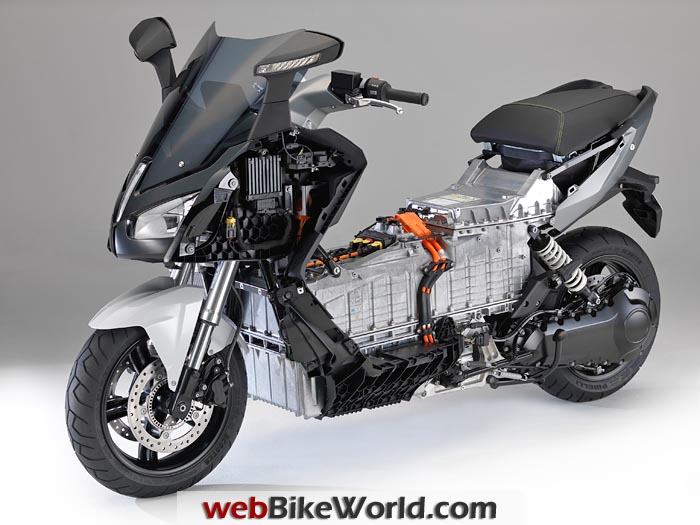
Liquid-cooled electric motor, air-cooled high-voltage battery and 100 km range
The C evolution is powered by a drivetrain swing arm with liquid-cooled permanent magnet synchronous motor via a toothed belt and ring gearing.
The rated power output is 11 kW (15 hp), with a peak output of 35 kW (47 hp).
This enables the C evolution to achieve a top speed of 120 km/h (75 mph, electronically limited) and gives it better acceleration than some maxi scooters powered by engines with displacements of 600 cc or more.
The generous 8 kWh capacity of the air-cooled lithium-ion high-voltage battery allows the two-wheeler to cover a range of up to 100 kilometers (62 miles) before it needs to be charged from any domestic mains supply.
When plugged in to a standard 220V domestic socket with a 12A charge current, recharging fully from empty takes around 4 hours (with 220V / 16A = 3 h).
The compact drive unit for the C evolution takes the form of a drivetrain swing arm, with a permanent magnet synchronous motor positioned behind the battery casing acting as an integral part of the swing arm.
Due to the close proximity of the swing arm axle and the electric motor’s output shaft, the moment of inertia around the swing arm’s pivot point is kept low, allowing for optimum suspension/damper settings as well as sensitive response.
A maintenance-free toothed-belt drive transmits the power from the electric motor to the rear belt pulley.
The torque is then directed to the rear wheel via a planetary gear with an overall reduction ratio of 1:8.28. The electric motor’s maximum rotational speed is 9,200 rpm.
The electric motor and its power electronics are liquid cooled, with the cooler located at the front right in the front cowling. An electric fluid pump is used to circulate the coolant.
One of the stand-out comfort features of the C evolution is its reversing aid. It is enabled via a control on the left handlebar, with a light jolt confirming activation for the rider.
With the activation button pressed, the C evolution can be reversed at no more than walking pace to make maneuvering easier. Activation of the reversing aid is also indicated in the TFT display by a corresponding ride enable message.
Battery Capacity
High battery capacity enables a high range of up to 100 kilometers (62 miles).
The battery’s considerable storage capacity of 8 kWh is sufficient for a range of up to 100 kilometers (62 miles) in Road mode (higher in Eco Pro mode), allowing practical travel with zero emissions in both city centers and any urban environment.
The lithium-ion energy storage modules are the same as those fitted in the BMW i3; they meet the most exacting standards in terms of both quality and service life, ensuring that the range of the C evolution is just as high even after many years of use or in cold weather.
The battery is made up of three storage modules, each comprising twelve cells with a capacity of 60 Ah and a nominal voltage of 3.7 volts. The cells used are prismatic lithium-ion cells.
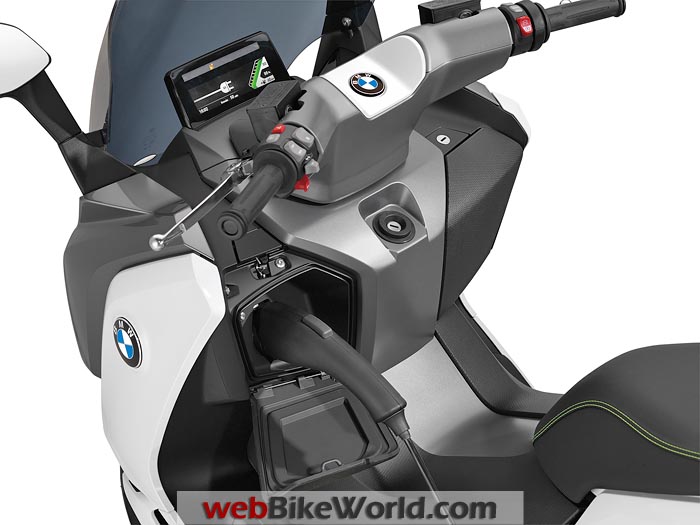
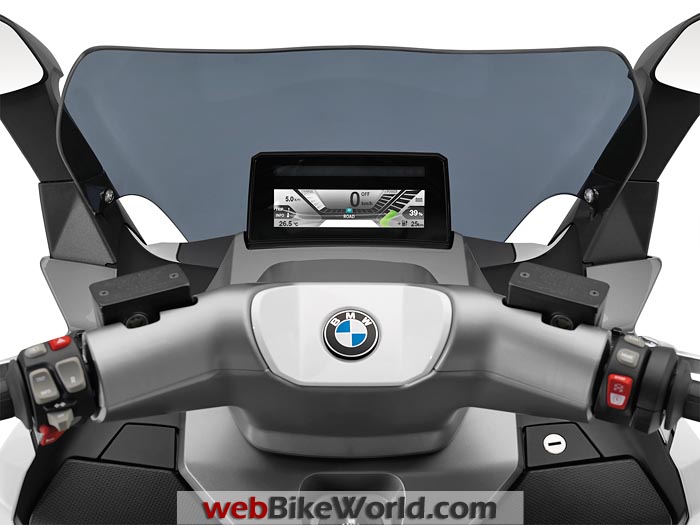
Air-Cooled Battery
The developers also invested a great deal of their technical expertise in the cooling of the high-voltage battery.
On the one hand, it was important to stop temperatures from dropping too low, as this would increase the cells’ internal resistance, thereby reducing power output.
At the same time, excessively high temperatures also had to be prevented in order to maximize cell life.
In contrast to the battery cooling systems with cooling agents that are employed in electrically powered cars, air cooling is used on the C evolution as this takes up less space and keeps the weight lower.
The heat from the high-voltage battery is dissipated by the air stream passing through a cooling air shaft positioned in the center of the battery casing so that it is facing the direction of travel.
In order to make cooling as efficient as possible, the base of the battery casing furthermore includes cooling ribs aligned in the direction of travel.
The battery’s diecast aluminum casing doesn’t just hold the battery cells, it also contains the electronics needed to monitor them.
The casing additionally acts as a load-bearing chassis element, dispensing with the need for a frame in the conventional sense.
The power electronics for the electric drive are installed behind the battery casing and take care of energizing the electric motor in a range between 100 and 150 volts, with a nominal voltage of 133 volts.
The power electronics also process the rider’s commands, such as throttle grip position, along with information from the braking system.
Furthermore, they control the energy recuperation process by deciding whether to apply recuperation torque to the rear wheel and how much depending on the rider’s inputs and the ride mode.
Short, practical charging times.
The C evolution is recharged via its built-in charger by connecting it to either a domestic mains socket or a suitable charging station.
The charging cable supplied as standard is fitted with the standard connector for the respective country’s domestic mains supply.
National variant coding ensures the maximum charge current is set to the correct value. If necessary, the rider can reduce BMW Media information 04/2014 Page 10 this charge current in increments by going to the set-up menu.
The charging socket is located behind a cover in the front left of the leg well.
When plugged in to a standard 220V domestic socket with a 12A charge current, fully recharging the battery from empty takes around 4 hours (with 220V / 16A = 3 h).
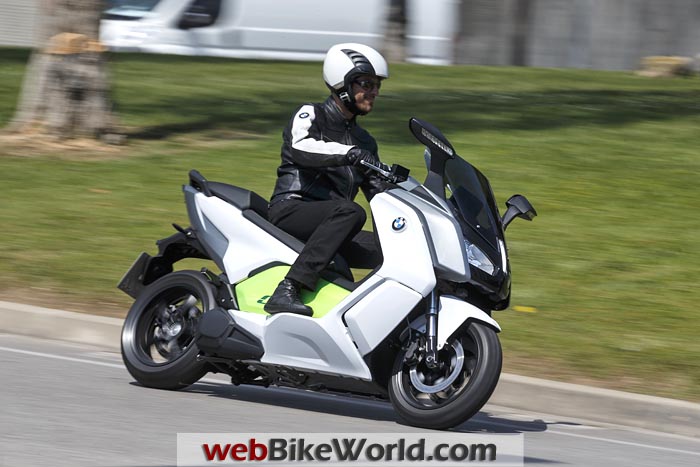
Intelligent recuperation and four ride modes
BMW Motorrad has opted for a form of energy regeneration for the C evolution that has never been seen before on a single-track vehicle.
Recuperation takes place automatically both when coasting with the throttle closed and when braking.
Riders of the C evolution can set their preferred mix of dynamic performance and efficiency by selecting from the four ride modes.
The new C evolution is available with Torque Control Assist (TCA), which works in a similar way to the Automatic Stability Control feature on BMW motorcycles with combustion engines.
TCA limits the motor’s torque depending on the slip at the rear wheel.
For optimum controllability of the drive torque, the electric motor’s control electronics monitor the rear wheel speed and reduce the drive torque if a certain plausibility threshold is exceeded, just as Automatic Stability Control does on BMW motorcycles with combustion engines.
TCA is therefore a particularly useful aid for the rider when starting off and prevents uncontrolled spinning of the rear wheel on road surfaces with reduced grip, such as wet cobblestones.
The Torque Control Assist additionally serves to stop the rear wheel from skidding when a sharp rate of recuperation produces a correspondingly high level of drag torque, especially on slippery road surfaces.
A choice of ride modes for efficient operation and everyday practicality.
During development of the C evolution, BMW Motorrad made it a particular priority to ensure that its riders would be able to enjoy either the greatest possible efficiency or maximum riding pleasure as desired.
As a result, the C evolution includes four ride modes.
Road mode: full accelerating power is available here, while energy is recuperated at a rate of approx. 50% when coasting with the throttle closed.
Recuperation takes place during braking as well. The standard operating range is achieved in this mode.
Eco Pro mode: the drag torque when coasting is increased significantly in this mode and a maximum recuperation rate together with the restricted accelerating power and the resulting limit on energy output enables the range to be extended by 10-20%.
The higher drag torque manifests itself for the rider as a sharper decelerating torque when the throttle is released. The highest range is achieved in this ride mode.
Sail mode: in this mode, the electric motor does not build up drag torque and recuperation only takes place when braking.
As a result, riders will notice that next to no braking torque is generated when the throttle is released, allowing the vehicle to glide along virtually free of any braking effect.
This is a riding experience that is unheard of on conventionally powered two-wheelers.
Dynamic mode: for extra-dynamic performance, this mode combines full accelerating power with a sharp rate of recuperation and therefore a high level of drag torque.
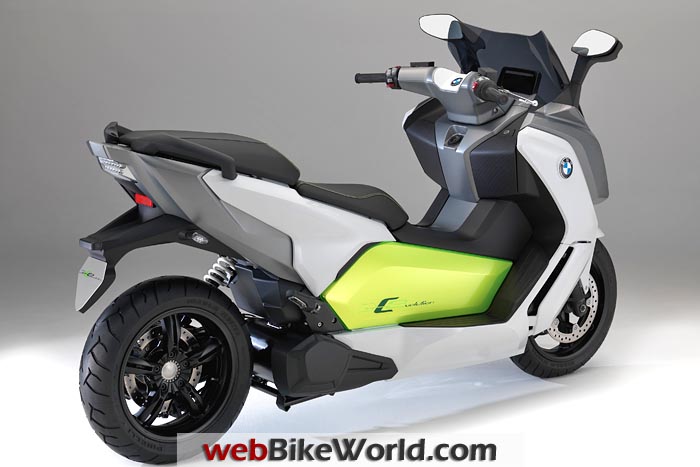
Energy regeneration when coasting and braking.
During development of the C evolution, BMW Motorrad opted for a form of energy regeneration (recuperation) that has never been seen before on a single-track vehicle and is perfectly transparent for the rider.
Recuperation takes place automatically depending on the selected ride mode.
This means that riders do not have to activate recuperation themselves and basically ride the C evolution in exactly the same way as a maxi scooter powered by a combustion engine.
Recuperation when coasting with the throttle closed: closing the throttle grip triggers recuperation in accordance with the selected ride mode.
As with a combustion engine, the electric motor’s generator function creates a drag torque or “motor braking” effect. Its intensity depends on the rate of recuperation, which can be varied by selecting from the different ride modes.
Recuperation while braking: recuperation is also carried out when braking, converting kinetic energy to electrical energy so as to charge the battery.
This process involves using sensors to pick up the brake pressures at the front and rear wheel brakes. If the power electronics detect a braking maneuver, the electric motor will automatically build up a drag torque so as to aid braking and recuperate energy.
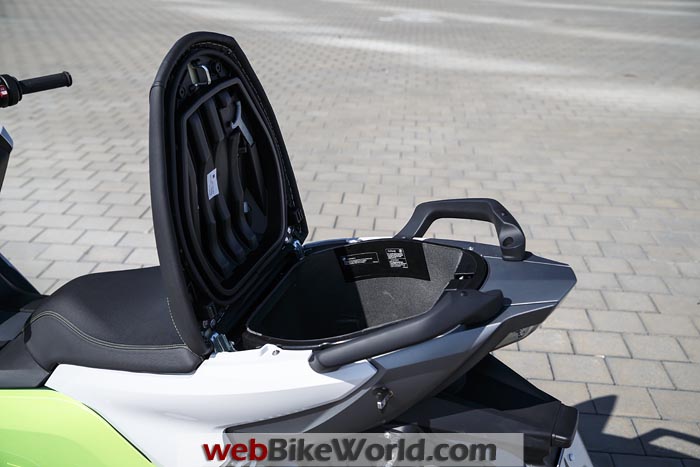
Safety synergies with BMW Automobile.
As part of the BMW Group, BMW Motorrad was able to harness synergies with BMW Automobile during development of the C evolution.
Besides adopting the same energy storage modules and electronic componentry used in the BMW i3, this was particularly beneficial for electrical safety, which is to passenger car standard.
The C evolution is the first electrically powered two-wheeler to meet the ISO 26262 standard for functional safety and the ECE R100 standard governing high-voltage safety, both of which have been ratified by the leading carmakers.
As far as the chassis is concerned, the C evolution no longer has a main frame in the conventional sense.
The central component here is the battery casing made from die-cast aluminum, which has a steering head support made from steel tubing attached to it at the front and, at the rear, the single-sided swing arm as well as a rear frame, also made from steel tubing.
The task of wheel suspension and damping is performed by an upside-down tele-hydraulic fork at the front and a spring strut mounted on the left at the rear.
As on all vehicles from BMW Motorrad, the C evolution comes equipped with safety-boosting ABS together with powerful disc brakes as standard.
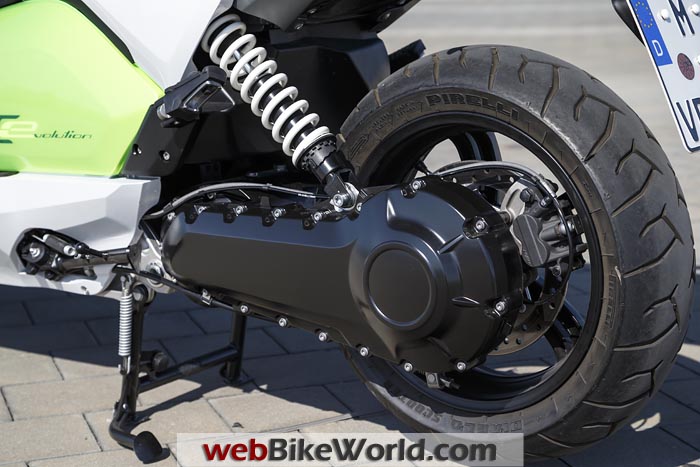
Torque Control Assist (TCA) for superior traction control.
The new C evolution is available with Torque Control Assist (TCA), which works in a similar way to the Automatic Stability Control feature on BMW motorcycles with combustion engines.
TCA limits the motor’s torque depending on the slip at the rear wheel.
For optimum controllability of the drive torque, the electric motor’s control electronics monitor the rear wheel speed and reduce the drive torque if a certain plausibility threshold is exceeded.
This is the same as Automatic Stability Control does on BMW motorcycles with combustion engines.
TCA is therefore a particularly useful aid for the rider when starting off and prevents uncontrolled spinning of the rear wheel on road surfaces with reduced grip, such as wet cobblestones.
The Torque Control Assist additionally serves to stop the rear wheel from skidding when a sharp rate of recuperation produces a correspondingly high level of drag torque, especially on slippery road surfaces.
A choice of ride modes for efficient operation and everyday practicality.
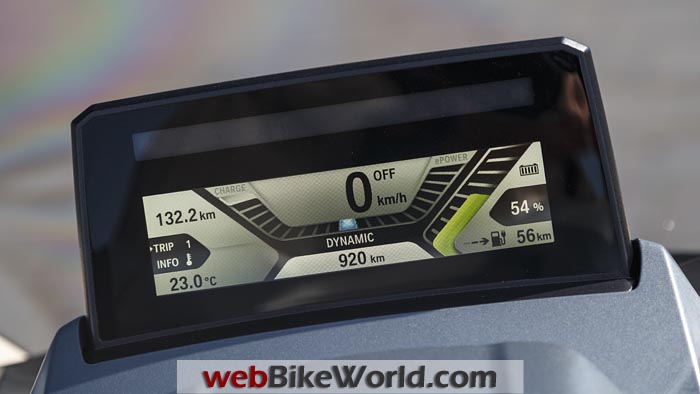
Large TFT colour display and LED daytime running light.
A host of other features further underline the innovative character of the C evolution. It is equipped with a reversing aid, for instance, that enables easy maneuvering at walking pace.
There is also a first in the form of an LED daytime running light, which additionally dims to double as the sidelight. And for added comfort on cold days, there are heated handlebar grips.
A large TFT color display in the instrument cluster offers a wealth of information.
Apart from the current speed, the rider is also kept informed of data such as the average consumption in kWh/100 km, total power consumption, battery charge status in kWh and average speed.
Also, voltage of the on-board electrical system and the high-voltage system, as well as the remaining range in kilometers taking into account the selected ride mode. A bar graph furthermore indicates the current level of energy draw or regeneration.
BMW C Evolution Scooter Specifications
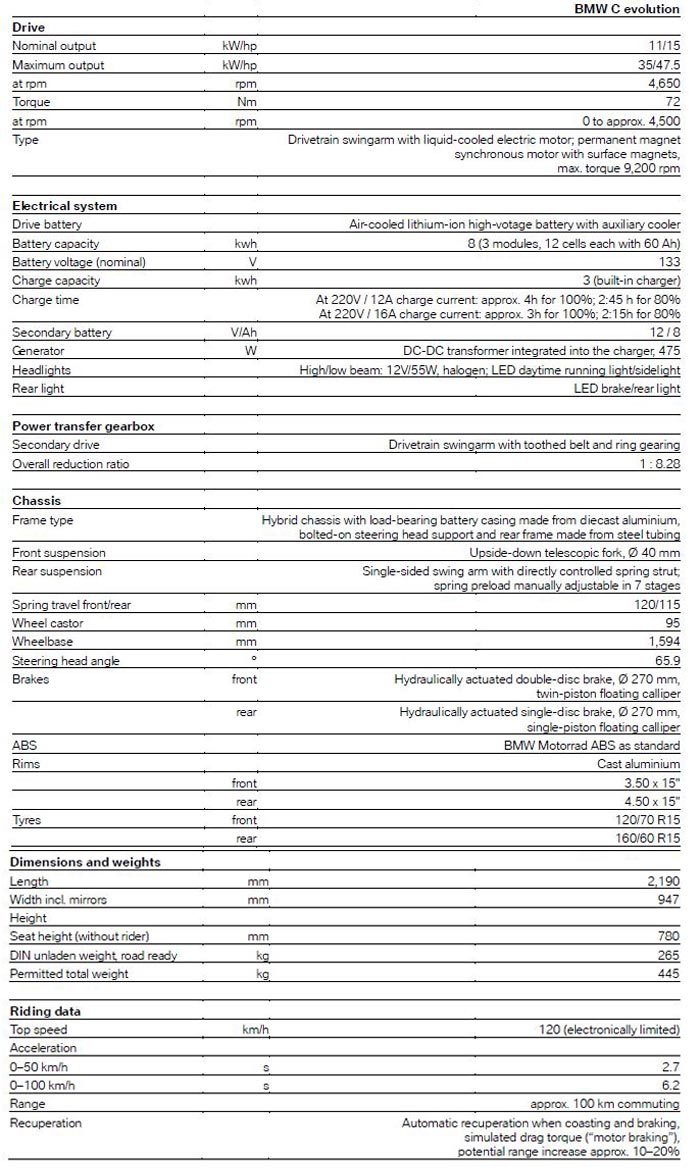
BMW C Evolution Scooter Torque Curve
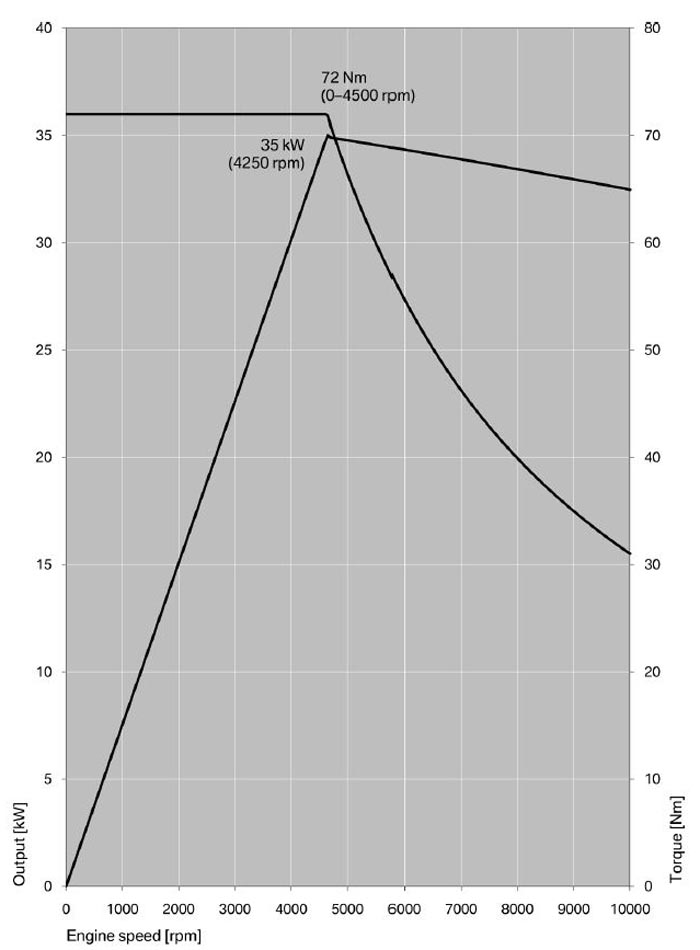
Publication Date: April 2014
Master Listing of All wBW Motorcycle Product Reviews
Owner Comments and Feedback
See details on submitting comments.


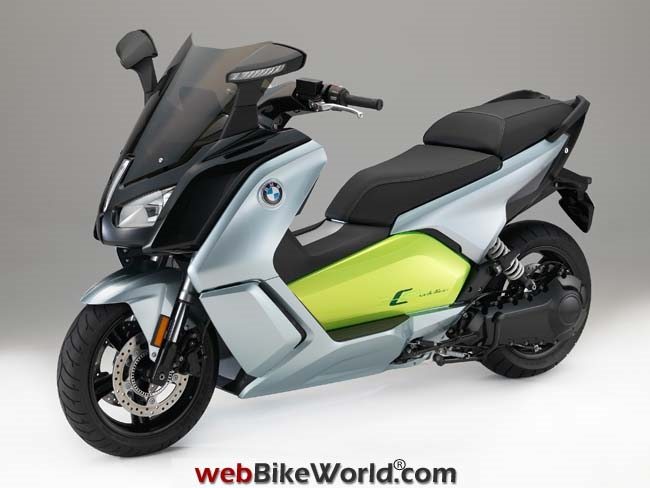
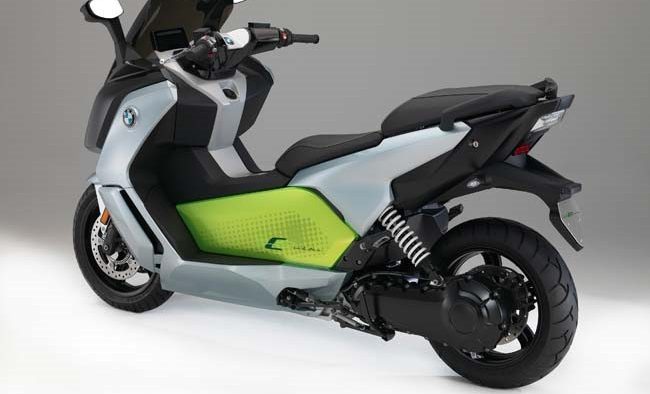

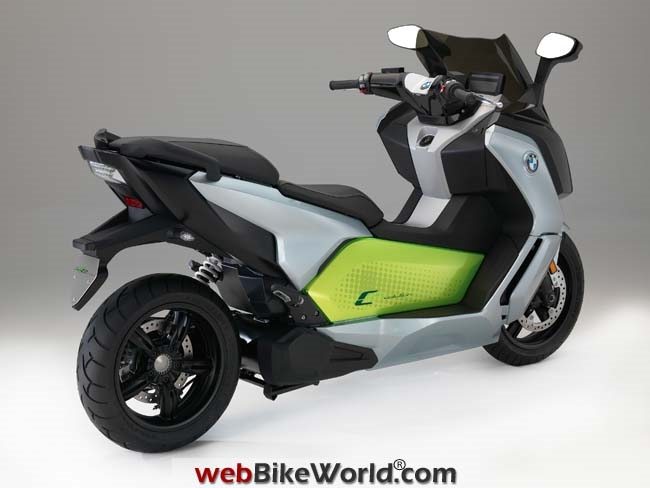
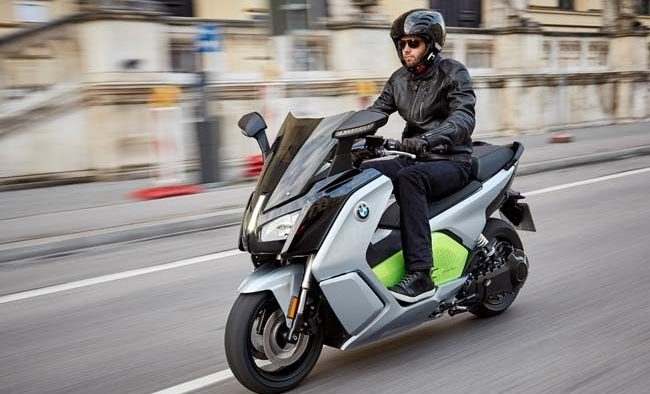
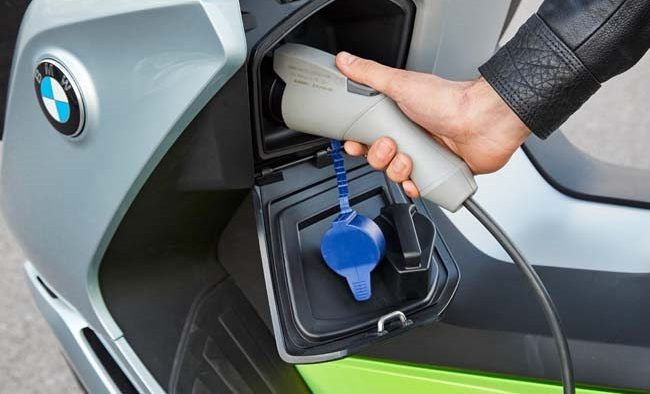
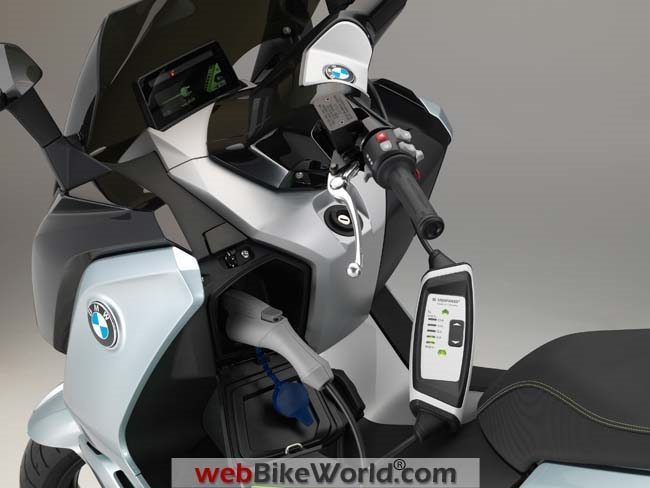
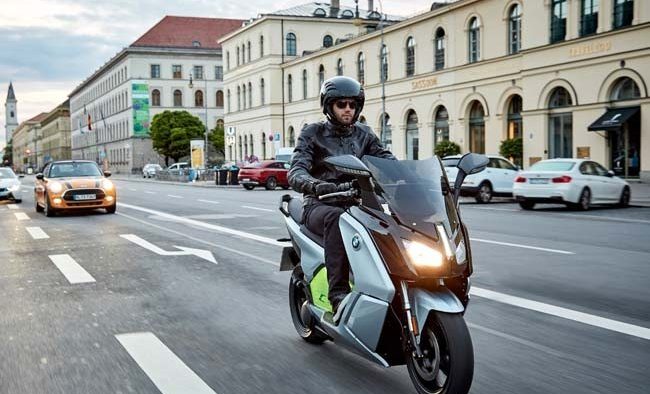
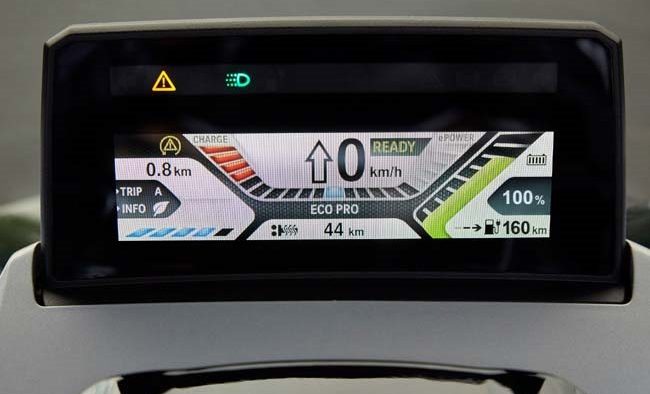
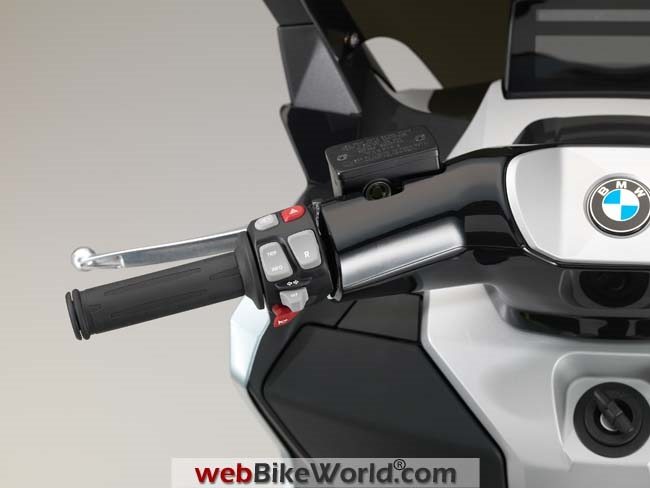
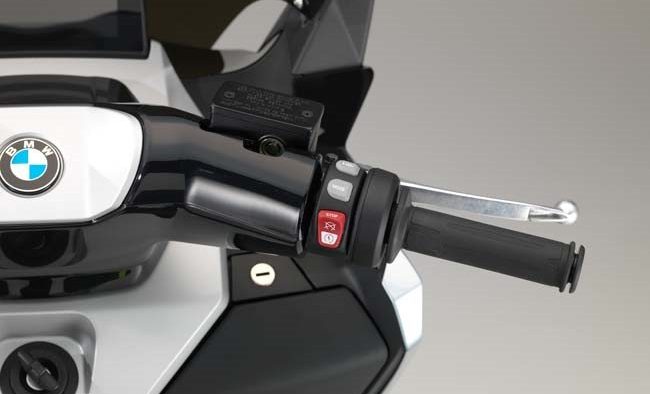
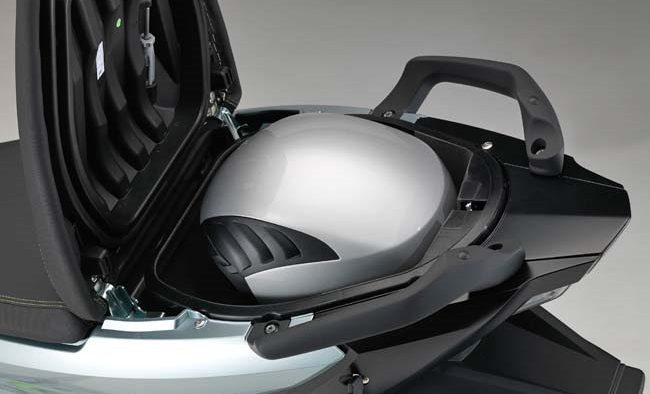
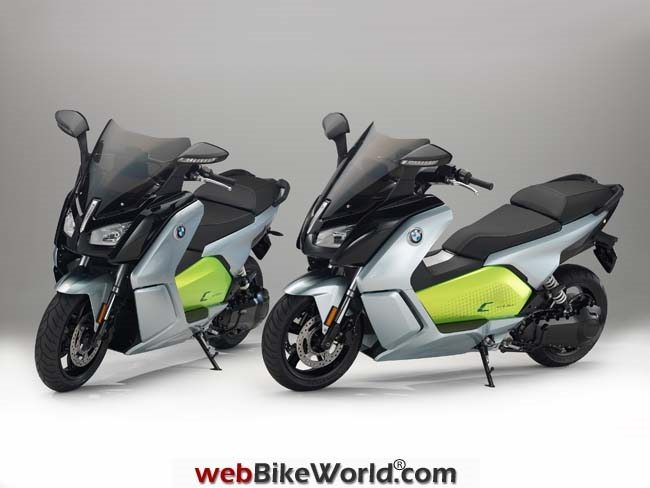
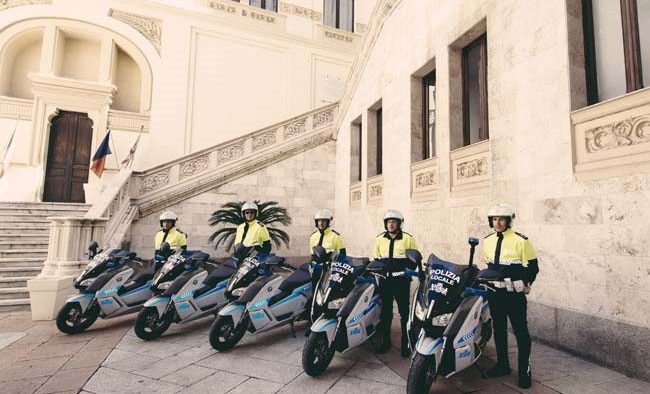
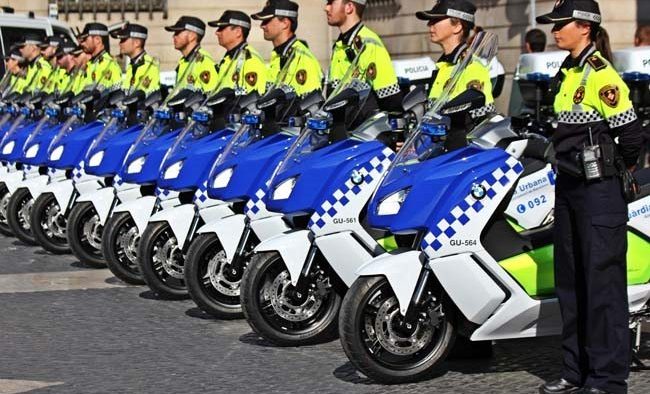

No Comment